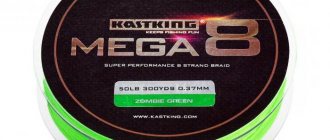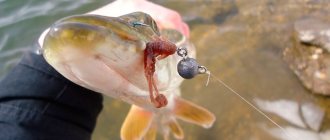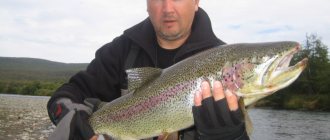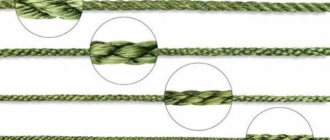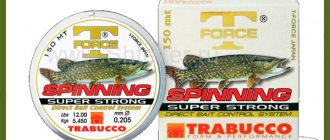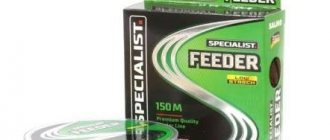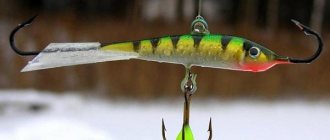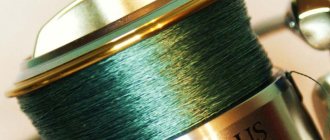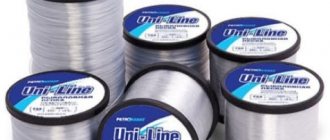| Place | Name | Characteristics in the rating |
| Top 10 best fluorocarbon fishing line manufacturers from AliExpress |
| 1 | GHOTDA | The most popular brand on AliExpress |
| 2 | Angryfish | Large selection of thickness and strength |
| 3 | KastKing | The best ratio of price and quality |
| 4 | Billings | The lightest fishing line |
| 5 | Mavllos | Best price |
| 6 | ILure | Maximum frost resistance |
| 7 | Shynapack | Better elasticity |
| 8 | Mosodo | Leashes with sealed fastening |
| 9 | JACKFISH | The best strength indicators |
| 10 | ZUKIBO | Carbon coated nylon |
Fluorocarbon fishing line is a relatively new product on the market. Its main advantage over conventional nylon thread is its invisibility. This became possible thanks to the use of special types of carbon plastic, which refracts light in the water in such a way that the fishing line becomes almost invisible. It is known that fish often bypass the fisherman’s bait when they see a thread or equipment, this is especially true when catching a cautious predator, such as pike perch or pike.
If you are not yet familiar with this type of equipment and are interested in it, then you need to understand that the fishing line also has its drawbacks. First of all, it is strength. It is much lower than that of nylon thread, so it should be selected as carefully as possible. Always take fishing line with a safety margin. In addition, fluorocarbon is rarely used as a main line. More often it is simply tied at the end, 3-5 meters long. This is quite enough to deceive the fish.
You should also consider the density of the fishing line. Durable plastic has virtually no memory, which is a plus, but the downside is that fluorocarbon is quite difficult to tie. Often the knots are either loosened or not tightened at all, so you should choose a tying method that is suitable for this type of equipment. Fortunately, the Internet is full of useful tips and tricks on this topic. As for the advantages, you will appreciate them after the first fishing. Just three meters of new equipment can significantly increase your catch, and despite the fact that fluorocarbon costs more than nylon thread, it makes sense to spend money on such equipment and deceive even the most cautious fish.
Myth 2 Fluorocarbon is not visible underwater.
Manufacturers claim that fluorocarbon is invisible under water, especially compared to monofilament, unfortunately this statement is quite difficult to prove or disprove, we do not know how fish see.
From various tests of these lines, there is little or no difference in visibility between nylon lines and fluorocarbon lines.
Refractive index:
- Water - 1,333.
- Fluorcarbon - 1.42.
- Nylon monofilament - range from 1.53 to 1.62.
As you can see, the difference in numbers is not big. Again, we should not forget that any fishing line, when lowered into the water, will create various vibrations and vibrations, which the fish perfectly feels with its lateral line, and the larger the diameter of the fishing line, the stronger these vibrations will be, so any fishing line under water will be noticeable to the fish.
This explains that the worse the bite in a pond, it is most effective to use a fishing line with small diameters, up to 0.08 mm, this reduces the vibrations of the fishing line in the water, and the fish are less afraid.
Here are the results of our test:
Layout for testing We recommend: Tench fish, photo and description, fishing tips
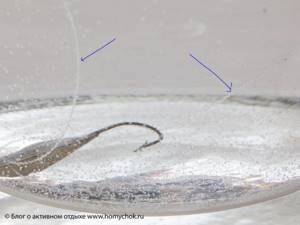
The photo clearly shows both types of fishing line; in the summer we will definitely conduct a test in a natural body of water, underwater, lowering the camera under water.
Beware of fakes
I would like to draw the attention of anglers who, after reading this article, will naturally want to purchase such a “magic” fishing line for themselves, to the fact that under the guise of fluorocarbon, unscrupulous sellers can “foist” ordinary fishing line. It’s quite easy to check what kind of fishing line they actually sell.

The fact is that fluorocarbon fishing line is made from fluorocarbon, and this material does not burn. Therefore, if you bring a lit match to the tip of a fluorocarbon fishing line, it will not shrink and melt like traditional thread, but will simply char, staining your fingers black.
Myth 3 Fluorocarbon is stronger than nylon thread.
There is an opinion and statements from sellers that, with the same diameter, fluorocarbon is stronger than monofilament, this is also not confirmed, but rather refuted by various tests.
Nevertheless, due to the properties of fluorocarbon, this fishing line can be perfectly used in salt water, in reservoirs with severe chemical pollution, if there is a possibility of the fishing line rubbing against stones, it is indeed more resistant to mechanical stress.
It makes excellent leashes and is difficult for predatory fish to bite through. Fluorocarbon makes excellent equipment for feeder fishing.
Everything else is nothing more than a marketing ploy by sellers to increase the cost of their product.
It makes no sense to use it as the main fishing line, as many anglers do, especially in winter fishing, unless you install the fishing rod in such a way that the fishing line rubs against the edge of the hole.
Test results based on which the above statements are made:
https://www.tackletour.com/reviewfluorocarbontest.htmlhttps://www.bigindianabass.com/big_indiana_bass/the-truth-about-fluorocarbon.html
Additionally, we suggest that you familiarize yourself with various real tests from different anglers:
Test from Youtube channel|Mikhail Gorodentsev
Video Youtube|Sergey Guryev
Share link:
Resistance of fluorocarbon lines to temperatures and mechanical stress
Fluorocarbon fishing lines for winter fishing retain their original properties much longer than conventional nylon models. They last for several seasons. This cannot be said about thin monofilaments. Many of them lose significant strength and have to be replaced the next season.
The strength of fluorocarbon remains after numerous contacts with the rod guides and the edge of the holes. These fishing lines have a special coating - smooth and hard. Thus, manufacturers received a material that has a minimum coefficient of friction when in contact with various objects.
Another very good quality of fluorocarbon fishing lines is their resistance to sub-zero and very high temperatures. They retain all properties at both -10 and +40. For this reason, fishermen willingly use them in summer and winter. Nylon fishing lines do not have these properties. At a temperature of -5 degrees, ordinary fishing line loses up to 30% in strength, while fluorocarbon can withstand loads at -30 degrees, losing only 3% in strength. And only at temperatures above 50 degrees does a significant decrease in the strength of fluorocarbon fishing lines occur, from 30 to 50%.
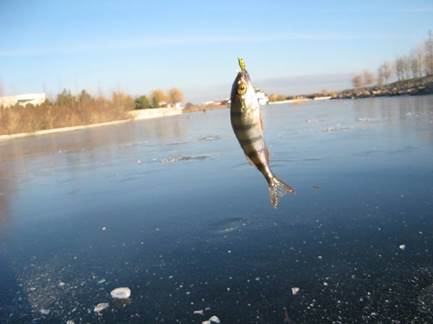
Fluorocarbon fishing line has amazing UV resistance. Based on reviews from anglers about winter fluorocarbon fishing lines, one can understand the difference between regular and fluorocarbon fishing lines. The first ones, after being in the open sun for 30-40 hours, already lose up to 50% of their strength. Fluorocarbons, on the other hand, can lose 5% at most.
Properties of fluorocarbon fishing line
Fluorocarbon was invented by Japanese engineers in the late 60s of the last century directly for the oil industry. But thanks to its qualities, this material has become widely used in the production of fishing line. How else?
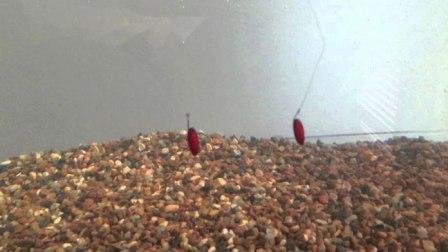
It would be foolish not to take advantage of the properties of the new chemical polymer, such as:
- resistance to high temperatures, as well as temperature changes (from minus 40 to plus 160 degrees);
- resistance to fairly aggressive chemicals;
- products made from it are wear-resistant and very durable.
In general, fishing line made from this material has simply magical properties. You can read the material about fishing rods for winter fishing.
We also recommend reading:
How to properly tie a jig to a fishing line Diagram on how to learn how to tie a hook to a fishing line Tourist knots - types and methods of tying Gardner's loop for a feeder: how to tie
